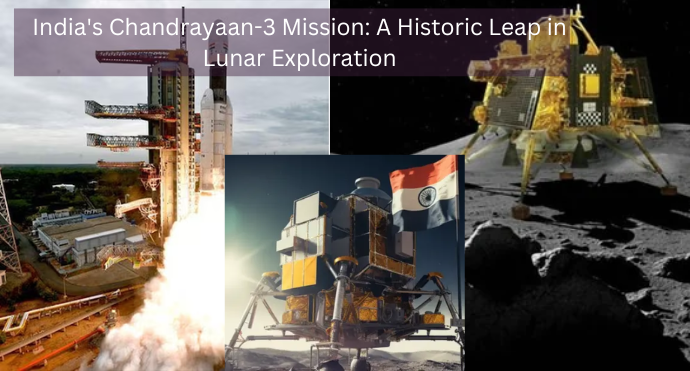On August 23, 2023, history was made as India’s Chandrayaan-3 mission achieved a successful soft landing on the lunar surface, marking a significant milestone for India’s space endeavors. This remarkable achievement places India in an esteemed league of nations, including the US, China, and Russia, that have achieved lunar landings.
The Chandrayaan-3 mission, launched on July 14, 2023, from Sriharikota, Andhra Pradesh, embodies India’s prowess in space exploration. Comprising a lander, a rover, and an orbiter, this mission is a testament to India’s scientific prowess and dedication to unraveling the mysteries of the cosmos.
Unveiling Lunar Secrets:
The key objectives of Chandrayaan-3 are as diverse as they are ambitious:
Geology and Mineralogy: The mission aims to extensively study the lunar south pole’s geology and mineralogy, shedding light on the Moon’s origin and evolution.
Water Ice Hunt: Chandrayaan-3’s rover, Pragyan, will scour the polar regions in search of water ice, a crucial resource for future lunar missions.
Lunar Atmosphere and Dust: By analyzing the lunar atmosphere and dust environment, the mission will expand our understanding of the Moon’s unique conditions.
Scientific Experiments: Chandrayaan-3 carries an array of scientific instruments, including a spectrometer, camera, and magnetometer, to conduct experiments and gather vital data.
Implications for India
The triumph of Chandrayaan-3 holds profound implications for India:
Global Space Standing: India’s success bolsters its status as a space power, attracting international recognition and respect.
Economic Boost: The accomplishment lures foreign investments into India’s burgeoning space sector, fostering technological advancements and collaborations.
Inspiring Youth: Chandrayaan-3 inspires young Indians to pursue careers in science, technology, engineering, and mathematics (STEM), contributing to India’s future technological landscape.
Job Creation: The mission generates job opportunities across various sectors, fueling economic growth.
Cross-sectoral Innovation: Technologies developed for space exploration find applications beyond the cosmos, including agriculture and healthcare.
Technological Marvels Behind the Success
The Chandrayaan-3 mission harnessed cutting-edge technologies to ensure its triumph:
Cryogenic Engine: Powered by a cryogenic engine, the spacecraft achieved efficient propulsion, essential for launching and landing on the Moon.
Lander Guidance System: The Vikram lander employed a sophisticated guidance system, incorporating laser altimeters, star trackers, and radar altimeters, for precise landing calculations.
Rover Navigation System: Pragyan’s navigation system employed cameras, laser range finders, and inertial measurement units to navigate the lunar terrain.
Scientific Instruments: The spacecraft’s spectrometer, camera, and magnetometer facilitate comprehensive lunar analysis.
The Digital Revolution in Lunar Exploration
Digital technologies were pivotal to Chandrayaan-3’s triumph:
Computer Control: Computers managed spacecraft systems, from propulsion to navigation, ensuring smooth operations.
Sensor Ensemble: Sensors monitored the spacecraft’s position, velocity, orientation, and environment for safe navigation.
Communication Infrastructure: Communication systems facilitated data exchange between the spacecraft and ground control.
Image Processing: Onboard software analyzed camera images, aiding terrain assessment.
Data Management: Extensive data storage systems managed scientific instrument data.
Conquering Challenges with Advanced Sensors
Chandrayaan-3’s array of sensors facilitated its safe navigation and data collection:
Laser Altimeter: Gauged spacecraft-to-lunar surface distance via laser reflection time.
Star Tracker: Tracked stars to determine spacecraft orientation.
Inertial Measurement Unit (IMU): Measured acceleration and angular velocity to calculate attitude and velocity.
Doppler Velocimeter: Detected frequency change in radio signals to determine velocity.
Hazard Avoidance Camera: Captured lunar surface images to prevent collisions.
Touchdown Sensor: Identified successful landing on the Moon.
Scientific Instruments for Lunar Revelation
Chandrayaan-3’s scientific instruments promised to reveal lunar secrets:
Spectrometer: Analyzed lunar surface chemical composition.
Camera: Captured high-resolution lunar images.
Magnetometer: Measured the Moon’s magnetic field.
X-ray Spectrometer: Analyzed X-ray emissions from the lunar surface.
Gamma-ray Spectrometer: Examined gamma-ray emissions from the lunar surface.
Looking Ahead: India’s Promising Space Odyssey.
Chandrayaan-3’s success propels India’s space journey to new heights. As India prepares for Chandrayaan-4 in 2024, armed with a more advanced rover, it solidifies its place as a leader in the global space arena.
In conclusion, Chandrayaan-3’s triumph reverberates beyond lunar exploration. It signifies India’s capability to innovate, inspire, and revolutionize technology. With this success, India embarks on a path to elevate its global standing while unearthing the cosmos’ profound secrets. The dedication of ISRO’s scientists and engineers ensures India’s continued ascent in space exploration, inspiring generations to come.



